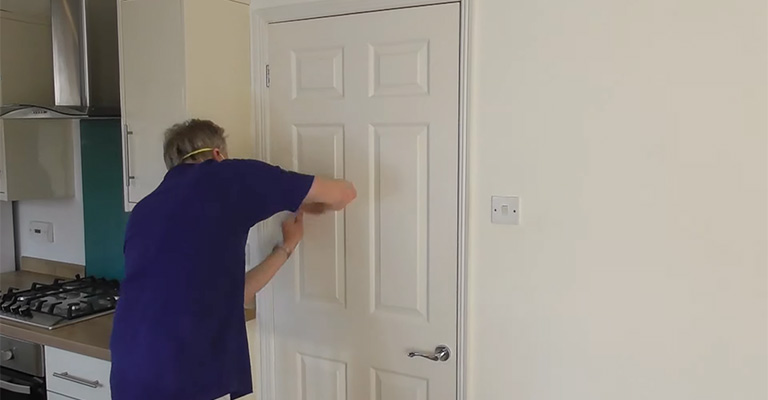Dealing with peeling latex paint on a door can be a frustrating and unsightly problem that homeowners often encounter.
Over time, weather exposure, temperature fluctuations, or even poor paint application can cause the once pristine finish to bubble, crack, and peel away.
But fear not, as there’s no need to replace the entire door to restore its beauty. To ensure that the new paint sticks to your trim, scrape off all the peeling paint before painting.
Using a scraper can be a challenge if the trim has carvings, raised moldings, or other difficult-to-reach features.
The use of household solvents and a toothbrush will prevent the wood from being scratched.
With the right tools, techniques, and a little elbow grease, you can bid farewell to those unsightly paint flakes and give your door a fresh start.
A Quick and Effective Way to Remove Peeling Latex Paint from Doors And Trims
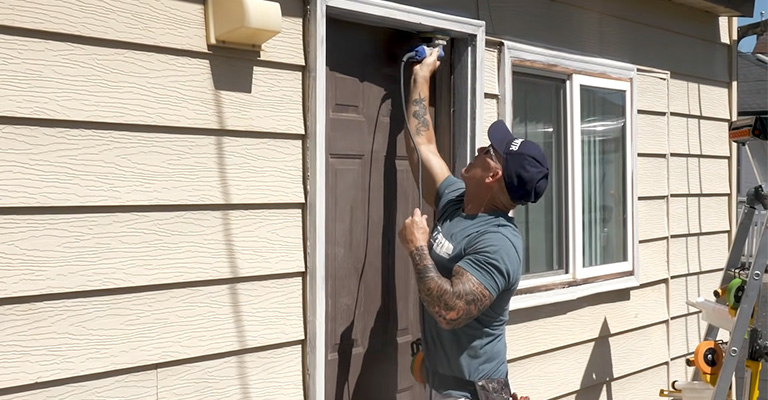
Keep old toothbrushes around your home if you do any DIY work around the house, since they’re useful for cleaning interior trim.
When removing old latex paint, first dip the toothbrush in alcohol to soften the paint so you can scrub it off.
For oil-based paint, use mineral spirits as a solvent. Using a rag, wipe the area you scrubbed dry after working the bristles into carvings and corners. Make sure the solvent is changed frequently.
To remove peeling latex paint from a door, follow these steps:
1. Gather Your Materials
You’ll need a few items to help with the paint removal process, including a paint scraper, sandpaper (medium grit), drop cloth or plastic sheeting to protect the surrounding area, a bucket of warm soapy water, a sponge, safety goggles, and a dust mask.
2. Prepare The Area
Lay down the drop cloth or plastic sheeting to protect the floor and surrounding surfaces from paint chips and dust.
3. Wear Protective Gear
Put on safety goggles and a dust mask to protect your eyes and lungs from paint chips and debris.
4. Loosen The Peeling Paint
Use a paint scraper to gently scrape away the peeling paint. Be careful not to damage the underlying wood or surface. Work in the direction of the wood grain if the door is made of wood.
5. Sand The Surface
After removing as much peeling paint as possible, use medium-grit sandpaper to smooth the surface and remove any remaining loose paint. Sand in the direction of the wood grain to avoid damaging the door’s surface.
6. Clean The Door
Dip a sponge into a bucket of warm soapy water and wipe down the door to remove any dust and paint residue. Let the door dry completely before proceeding.
7. Inspect For Remaining Peeling Paint
Check the door for any remaining peeling paint. If you find any, repeat the scraping and sanding process until the surface is smooth and all loose paint is removed.
8. Prime The Door
To ensure a good paint adhesion, apply a coat of latex primer to the door. Allow the primer to dry according to the manufacturer’s instructions.
9. Paint The Door
Once the primer has dried, you can proceed to paint the door with latex paint. Use a paintbrush or a paint roller, depending on your preference, and apply the paint in thin, even coats. Allow each coat to dry before applying the next one.
10. Let The Paint Cure
After the final coat of paint has been applied, allow the door to dry and cure fully before using or closing it. Follow the paint manufacturer’s recommended drying and curing times.
Remember to always work in a well-ventilated area and take proper safety precautions when dealing with paint and paint removal.
If you’re unsure about the process or dealing with a large peeling paint issue, it may be best to consult a professional painter for assistance.
Here Are Some More Quick Fixes for Peeling Latex Paint on Doors
In addition to the above methods, there are other ways to remove latex paint that may be more suitable for your needs.
Option 1: Use A Steamer
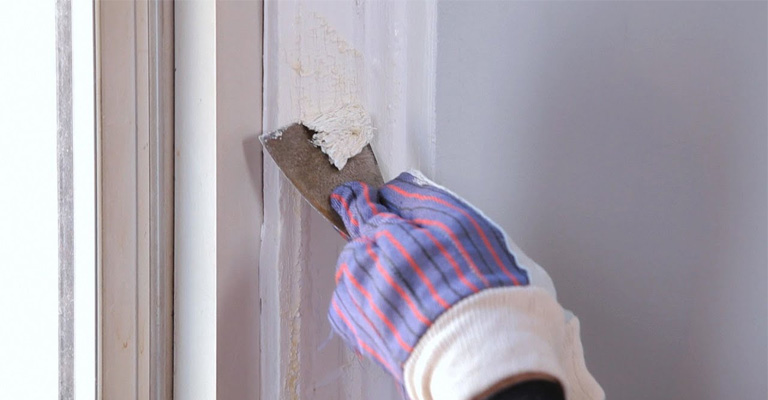
Using a steamer to remove latex paint from a door is indeed a viable option, especially if you have a significant amount of peeling paint to remove. Here’s how you can do it:
- Rent or buy a wallpaper steamer: Wallpaper steamers can be rented or purchased from hardware stores or home improvement centers. Make sure to get one with enough capacity and power to handle the task.
- Prepare the area: As with any paint removal method, protect the surrounding area with drop cloths or plastic sheeting to catch paint chips and debris.
- Wear protective gear: Wear safety goggles and a dust mask to protect your eyes and lungs from any paint chips and steam.
- Fill the steamer with water: Follow the manufacturer’s instructions to fill the steamer’s reservoir with water and allow it to heat up until steam is produced.
- Apply steam to the peeling paint: Hold the steamer’s steam plate or pad against the peeling paint on the door for several seconds. The steam will help loosen the paint from the surface.
- Scrape the paint off: After applying steam to a section of peeling paint, use a paint scraper to gently lift the softened paint from the door. Be careful not to damage the door’s surface.
- Continue steaming and scraping: Work your way around the door, steaming and scraping small sections at a time until you have removed all the peeling paint.
- Clean the door: After removing the peeling paint, wipe down the door with a sponge and warm soapy water to remove any remaining paint residue.
- Let the door dry: Allow the door to dry completely before proceeding with any further painting or finishing.
- Prime and repaint (if necessary): If the door’s surface requires repainting, follow the steps mentioned in the previous answer (steps 8, 9, and 10) to prime and paint the door.
Using a steamer can be a more gentle and less abrasive method of removing paint compared to scraping and sanding, which might be especially beneficial if you’re dealing with delicate or detailed surfaces.
However, always exercise caution when using a steamer, and make sure to follow the manufacturer’s instructions and safety guidelines for the specific model you are using.
Option 2: Use Heat Gun
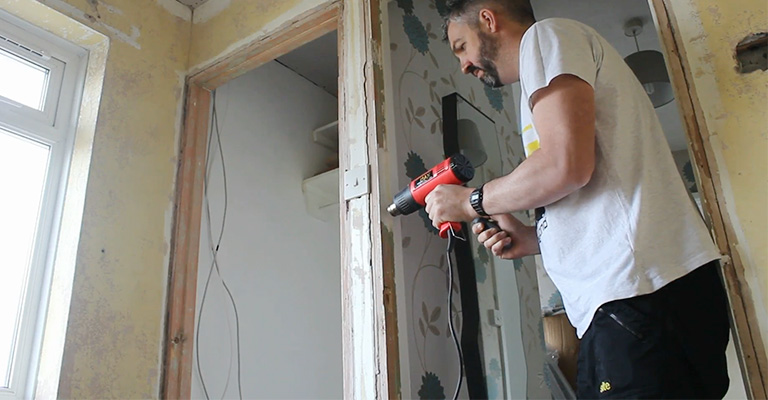
A few stubborn patches will never go away. Heat guns or chemical strippers may be necessary in these situations.
The purpose of a heat gun is to loosen the bond between the paint and the door by heating it. Scraping off the paint is easier this way.
Option 3: Using A Mild Paint Stripper
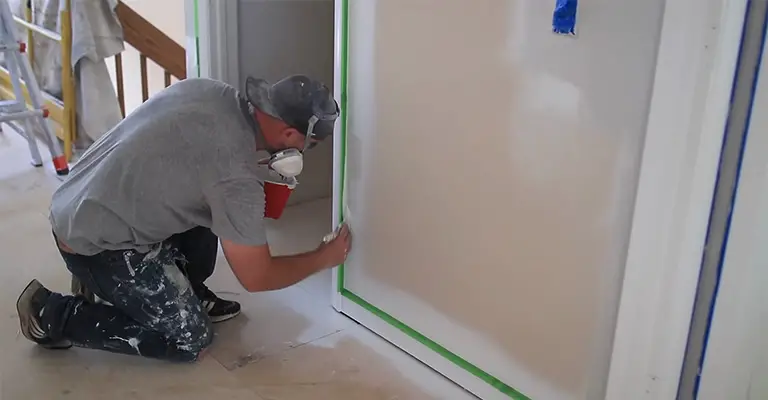
It is generally impossible for latex paint to adhere to oil-based paint, and it will peel off the wall after some time, leaving an unsightly stain.
In order to fix this problem, you simply need to remove the latex paint without damaging the oil-based paint underneath.
Step 1
Mix one gallon of warm water with one tablespoon of liquid dish soap. Use a wooden spoon to mix. Make sure the sponge is damp, not soggy, by soaking it in the mixture and wringing out the excess liquid.
Step 2
Remove the latex paint from the walls by scrubbing them with the sponge. Make sure all latex paint has been removed by scrubbing the walls and peeling away any loose paint. In the event that latex paint remains, proceed to Step 3.
Step 3
In a plastic paint tray, pour a mild paint stripper. To remove latex paint, dip a paintbrush into the mild paint stripper.
Step 4
Let the paint stripper sit for the predetermined amount of time on the wall. There is a specific time frame for each brand of paint stripper.
It typically takes 20 to 30 minutes for paint strippers to soften latex paint. Check your brand’s label for instructions.
Step 5
Plastic paint scrapers can be used to remove paint strippers and softened latex paint from walls.
Use paper towels to wipe the scraper after each pass to remove any chemicals and paint. Continue until the oil-based paint is completely free of latex paint.
Step 6
Use 1-gallon water and 1 tbsp liquid dish soap solution to clear away any paint stripper residue from the walls.
Make sure the wall is thoroughly cleaned by using a lint-free cloth soaked in the mixture. Also, make sure the walls are completely dry before painting.
What Causes Latex Paint to Peel?
A variety of factors can cause latex paint to peel, including poor adhesion, improper preparation, and unsupported surfaces. Below are some of the reasons.
Unsupported Surfaces
There are some surfaces that shouldn’t be painted, such as plaster or drywall. Paint will peel off these surfaces within a few days if you paint them without a primer or sealant. Make sure you only paint surfaces that are meant to be painted to avoid this.
Improper Prep Work
It doesn’t matter what type of paint you use or what primer you use, if you don’t prep the surface first, you won’t receive good results. The best way to do this is to clean it thoroughly with soap and water (or degreaser if necessary).
In order for the paint to adhere to the surface, you should also sand it down to create a rough surface. Leaving this step out will result in the paint not gripping onto the surface, resulting in peeling after a few weeks.
Poor Adhesion
Paint peeling is often caused by poor adhesion. Whenever paint is applied to an unsuitable surface or prep work is not done correctly, this can happen.
It is likely that the paint will start peeling after a few weeks if painted over bare wood without priming first.
Likewise, paint will not adhere properly to glossy surfaces, such as Formica or tile, and will peel soon after application. You’ll probably end up peeling paint if you apply latex paint over oil-based paint.
Can you Paint Over Peeling Latex Paint?
Yes, in a nutshell. It is possible to paint over peeled off latex paint. For your new paint job to look its best, there are a few things you should do first. In order to remove loose or flaking paint, you’ll first need to scrape it off.
For a smooth paint base, sand the surface next. Before painting, apply a primer. You can achieve a professional-looking finish by painting over dried paint by following these steps.
Is Primer Effective in Preventing Latex Paint from Peeling?
Primers prevent paint from peeling by forming a protective barrier between paint and surface. Paint adheres better and lasts longer when it is applied before painting.
Depending on the type of surface you are painting, there are many different types of primer.
Is It Possible to Remove Peeling Paint Without Damaging the Door?
It is possible to remove peeling paint without damaging a door, but care must be taken. Making sure they do not scratch the door would prevent them from gouging it with the tools.
Can You Use Synthetic Steel Wool Pad to Remove Peeling Latex Paint from the Door?
Using synthetic steel wool pads, you can remove peeling latex paint from doors. There is no need for special equipment or skills to perform the process. Using steel wool, wet it with water and rub it over the paint.
Small pieces of paint will come off. Getting all of the paint off may require a little elbow grease, but it should be relatively simple.
Is it Possible to Sand off Peeling Latex Paint?
It is best to use a paint stripper to remove peeling latex paint. By doing so, you will ensure that all the paint is removed without causing any damage to the surface underneath. The surface can then be sanded and painted after the paint has been stripped off.
Final Words
Scraping, washing, and scrubbing are unlikely to remove peeling paint. In this case, a light scuff sanding should remove it.
With a 150-grit sanding sponge, you can get the job done more easily and won’t get clogged up as easily as with sandpaper. Apply primer and the first coat of paint after wiping the trim down with a rag.
You can prepare the surface for the second coat by scuffing it up with the sponge before applying it. The transformation of the trim with paint can take some patience, but you’ll be pleased with the results.

